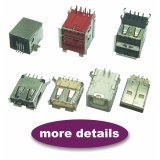Products
- Connector
- Cable Assembly
- Adapter
Standard USB
USB connectors are designed to be robust. The electrical contacts in a USB connector are protected by an adjacent plastic tongue, and the entire connecting assembly is usually further protected by an enclosing metal sheath. The connector construction always ensures that the external sheath on the plug contacts its counterpart in the receptacle before the four contacts within are connected. The USB 1.0 specification model was introduced in 1996. The USB 2.0 specification was released in April 2000 and was standardized by the USB-IF at the end of 2001.
The standard A type of USB connectors takes on the appearance of flattened rectangles that plugs into downstream-port sockets on the USB host or a hub. This kind of connector is most frequently seen on cables that are permanently attached to a device, such as one one a cable that connects keyboard or mouse to the computer. Standard-B connectors looks square with beveled corners, and plugs into upstream sockets on devices and hubs. The standard-B connector is mainly used only for the device end of a removable cable, such as between a hub and a printer. This two-connector scheme prevents a user from accidentally creating a loop.
Panstrong is the member of USB IF. It provides the USB 2.0 certified connectors
Description and Features:
Fully complies to USB 2.0 specification and tested to meet USB specification
Pass single attenuation test with 400MHZ in accordance with ASTM-D-4566
Contact resistance less than 30m even after 1500 mating cycles
No discontinuities during random vibration test
Single, double, triple deck available for type A receptacle
Applications:
PCs
Computer Peripherals
Digital Consumer Electronics Products
Imaging Devices


